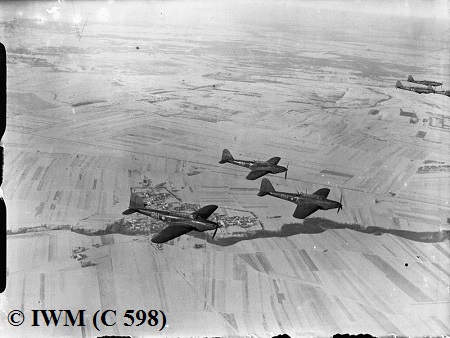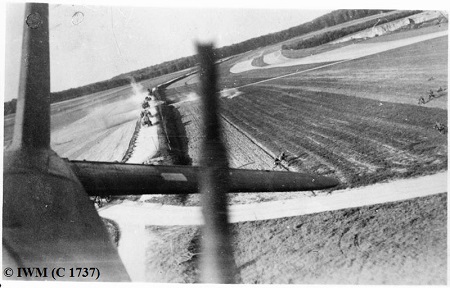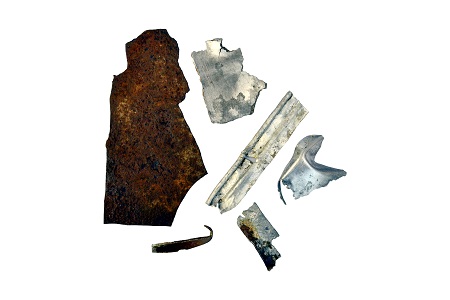Fairey Battle
Nationality: British
Serial number: L5546
Unit: 12 Squadron
Call sign: PH – U
Date of loss: 8/06/1940

Relics from a Fairey Battle light bomber of No. 12 Squadron, RAF. At approximately 3.15pm on the 8th June 1940, this aircraft was carrying out a low-level attack on German armoured columns west of Aumale, when it was shot down by a ME109 of Stab I (J) LG2 flown by Hauptman Hannes Trubenbach. The pilot, Flying Officer Bereton, baled out and was captured, but regretably his observer, Sergeant JP Boddington, and gunner LAC CS Burt, were both killed in the crash. They are buried in the Commonwealth War Graves plot in Abbeville Communal Cemetery.

The relics pictured here consist of a section of armoured plate to protect the pilot, a small section of the Rolls-Royce Merlin engine casing and a few pieces of the aircraft's airframe.
Nationality: British
Serial number: L5546
Unit: 12 Squadron
Call sign: PH – U
Date of loss: 8/06/1940

Relics from a Fairey Battle light bomber of No. 12 Squadron, RAF. At approximately 3.15pm on the 8th June 1940, this aircraft was carrying out a low-level attack on German armoured columns west of Aumale, when it was shot down by a ME109 of Stab I (J) LG2 flown by Hauptman Hannes Trubenbach. The pilot, Flying Officer Bereton, baled out and was captured, but regretably his observer, Sergeant JP Boddington, and gunner LAC CS Burt, were both killed in the crash. They are buried in the Commonwealth War Graves plot in Abbeville Communal Cemetery.

The relics pictured here consist of a section of armoured plate to protect the pilot, a small section of the Rolls-Royce Merlin engine casing and a few pieces of the aircraft's airframe.

The photographs depict Battles in a similar low-level attack on a German horse-drawn transport column just outside Dunkirk.

As early as September 1939, heavy losses in daytime sorties exposed the weakness of the Fairey Battle and it was withdrawn temporarily from daylight operations. The aircraft's modest speed and its poor defensive armament made it highly vulnerable to modern fighters such as the ME109 and ME110 and German mobile flak units. However, following the commencement of the German Blitzkrieg, the Battle squadrons were forced into making virtually suicidal low-level daylight attacks on roads, bridges and transport columns in an effort to slow the German advance. The loss rates of the Battle and Blenheim crews during the Battle of France were the highest ever experienced in the history of the RAF. The courage of these men is summed up by a quote from Pilot Officer Paul Richey, who flew Hurricane fighters in France with No. 1 Squadron.
"We had already done a certain amount of liaison and co-operation with the Battles – practice attacks on them and so on – and we sympathised with them in their slow, under-armed machines. But they were pathetically confident in their tight formation and fire concentration tactics. We admired their flying and guts, but although we gave them as much practice and encouragement as we could, we didn't give much for their chances."
Back

As early as September 1939, heavy losses in daytime sorties exposed the weakness of the Fairey Battle and it was withdrawn temporarily from daylight operations. The aircraft's modest speed and its poor defensive armament made it highly vulnerable to modern fighters such as the ME109 and ME110 and German mobile flak units. However, following the commencement of the German Blitzkrieg, the Battle squadrons were forced into making virtually suicidal low-level daylight attacks on roads, bridges and transport columns in an effort to slow the German advance. The loss rates of the Battle and Blenheim crews during the Battle of France were the highest ever experienced in the history of the RAF. The courage of these men is summed up by a quote from Pilot Officer Paul Richey, who flew Hurricane fighters in France with No. 1 Squadron.
"We had already done a certain amount of liaison and co-operation with the Battles – practice attacks on them and so on – and we sympathised with them in their slow, under-armed machines. But they were pathetically confident in their tight formation and fire concentration tactics. We admired their flying and guts, but although we gave them as much practice and encouragement as we could, we didn't give much for their chances."
Back
